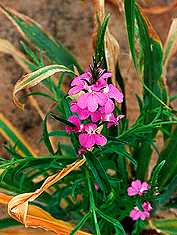Striga weed
Scientific name:
Striga hermonthica, S. asiatica, S. aspera, S. forbesii, S. gesnerioides
Common name: Witchweed
 Striga hermonthica
Striga hermonthica
Photo courtesy of A. Larsen
Affected crops
Corn, millets, rice, sorghum, and sugarcane are the hosts for the first 4 Striga species, while
S. gesnerioides is a parasitic weed of cowpea and wild legumes
Distribution
Mostly in Africa but also found in Asia and the USA
Description
Important species
- S. asiatica
The stems are hairy, hard, quadrangle-
shaped, and fibrous. The leaves are about 4 cm long and 1.5 -3.5 mm wide. The flowers are alternately arranged in the spike, much smaller than those of S. hermonthica but more prominent. The colors vary from red, pink, orange, yellow, white, or purple.
- S. aspera
The stems are delicate and profusely branched. The plants never grow more than 50 cm tall. The leaves are linear, opposite, spreading, or ascending and usually very narrow, 1-3.5 cm long and up to 5 mm wide. The flowers are very similar with those of S. hermonthica.
- S. gesnerioides
As compared to the other species, the plant is often pale-green with many closely packed stems at the ground level. The flowers are usually purple but are sometimes white or yellow.
- S. hermonthica
The stems are hairy, hard, quadrangle-shaped, and fibrous. The leaves are narrow and gradually decreasing towards the tip. The size is 2.5-7.5 cm long
and up to 2 cm wide. The flowers are found in a dense spike. Each spike may contain 6-10 open flowers. The colors vary from bright pink, rose-red, and white.
Effect and impact
The symptoms on corn are difficult to distinguish from those caused by lack of water (drought), like wilting and curling of leaves at an early stage. The infected plant may also show stunting and a pronounced burning of the leaf borders. The leaves are 'burnt' when the parasitic weed dominates over the corn plant.
Striga weeds are difficult to control once they are established on corn plants. Because they get their nutrients from corn, they contribute to the latter's very low production in most countries in Africa.
Conditions that favor development
- Overused, depleted, and infertile soil
- Poorly manage soil
- Monocropping, planting of the same crop on the same area for a long period of
time
- Improper weed management
- Seeds from the previous harvest are mixed with Striga seeds
Methods of control
- Proper seed selection
- Use seeds that are Striga seeds-free. Avoid using seeds from the previous harvest if the crops were infested with Striga. Buy the seeds for your next cropping from an agricultural seed store in your locality.
- Regular plant monitoring
- Intercropping sorghum with cowpea
- Intercropping corn with silver leaf desmodium (Desmodium uncinatum) or green leaf desmodium (D. intortum). Desmodium is a leguminous plant that is a good source of fodder for the farm animals. When planted as an intercrop, it covers the surface in between the rows of the main crop (corn, sorghum, or millet). Desmodium emits chemical into the soil that is unfavorable for Striga's growth. 2.5 kg of seeds are needed for 1 ha.
- Hoeing and hand weeding before Striga plants start to flower. Late weeding requires the burning of collected plants to kill the seeds. Never put them in your compost pile or pit.
- Off-barring and hilling-up the rows
- Apply organic fertilizer and other organic soil supplement to improve the crop's stand.
- Crop rotation with legumes such as soybean, mungbean, and other leguminous crops, to improve the soil condition and deprive the parasitic weeds from favored host plant

